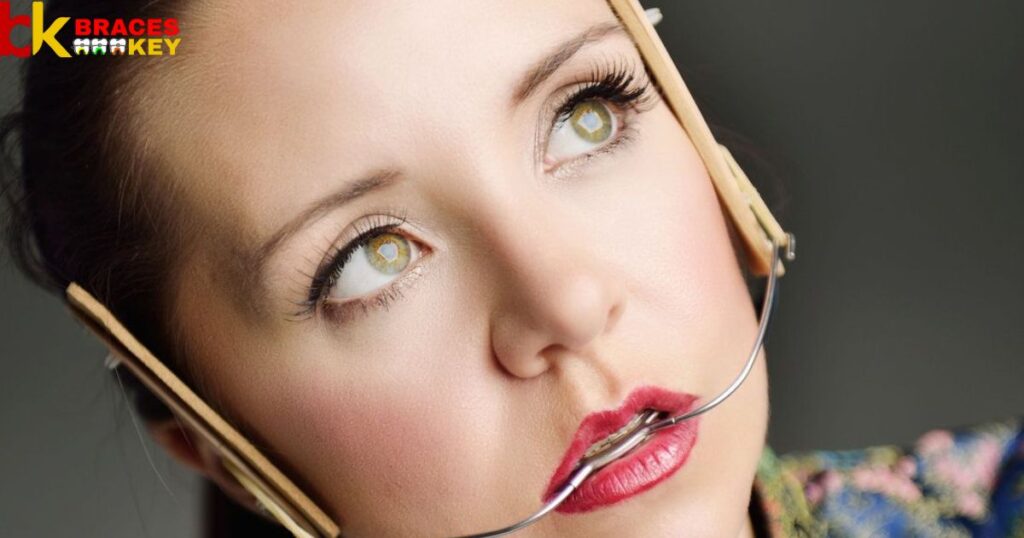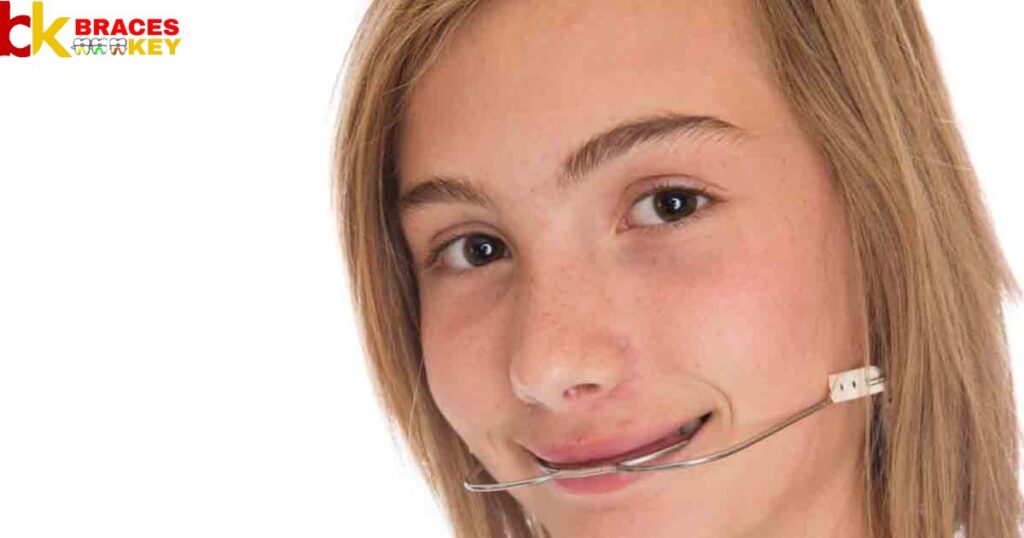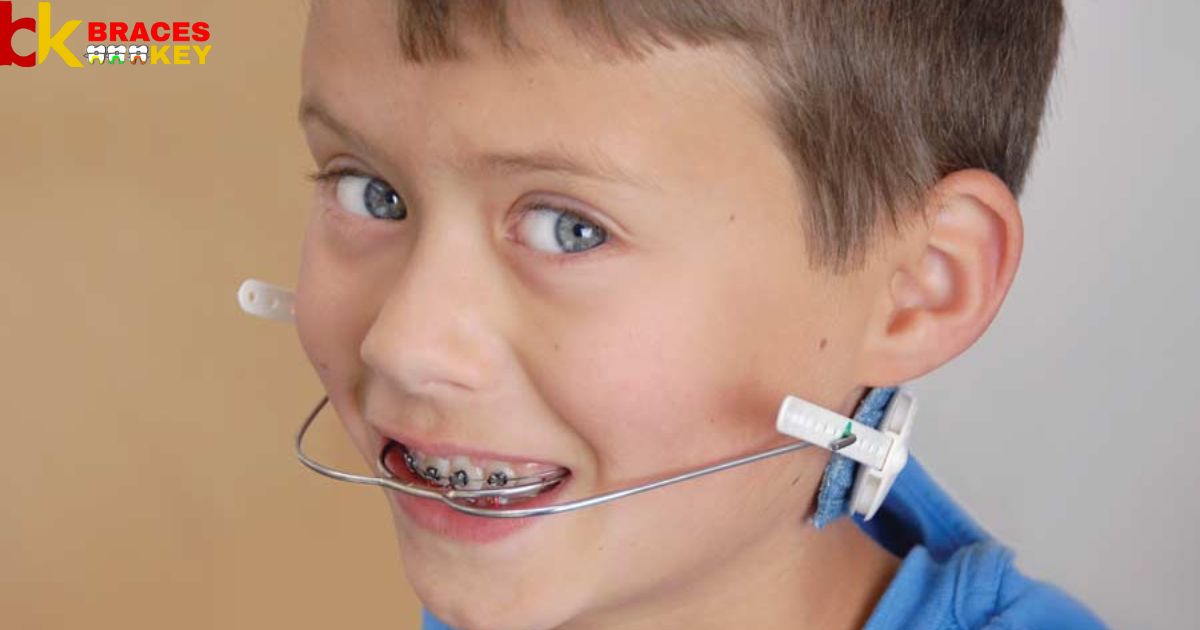Orthodontic headgear is equipment prescribed by an orthodontist to help correct severe overbites in growing children. Worn at night, the metal framework gently applies light pressure to the teeth to guide jaw alignment.
Anyone who had braces as a kid may remember the strange contraption worn outside of pajamas at night – orthodontic headgear. Beyond looks, this tool served an important purpose in overbite treatment.
By connecting to braces and a removable facemask/headgear part, orthodontists can slowly shift problematic overbites into a healthier jaw position over time. Nightly wear helps guide correction without interfering with daily activities. Overbites left unchecked could cause long-term issues, so headgear plays a role in proper development.
Key Takeaways
- Headgear applies gentle pressure over many months/years to gradually shift jaw alignment, unlike quick but painful jaw surgeries.
- Worn only at night preserves a child’s self-esteem by avoiding headgear during school/activities.
- Guide tubes connect elastic threads from headgear to braces, transferring corrective forces to problem teeth roots.
- Overbites develop from genetics and thumb/finger-sucking behaviors, so headgear interventions catch issues early. Don’t miss to read out this topic Rubber Band Colors.
- Orthodontists monitor progress with routine appointments and X-rays, fine-tuning headgear settings to track steady jaw repositioning over time.
Overview Of Overbite With Orthodontic Headgear

For young mouths struggling with severe overbites, orthodontic headgear comes to the rescue overnight. Worn like a crown outside pajamas, its metal framework and wire teeth-guiding runways redirect misaligned jaw growth subtly in sleep.
Connected braces allow symmetrical pressure shifting to take hold gradually. By dawn, smiles are tracking closer to balanced bite perfection thanks to nights tucked safely wearing the incognito improver hugging youthful faces toward healthier grins.
Step By Step guide To Overbite With Orthodontic Headgear
- Custom headgear is fitted to the child’s braces and face for a precise fit. Elastic threads are hooked to selected teeth to apply targeted pressure from specific angles.
- At night’s start, the easily worn apparatus is snapped into place, enclosing the head in a stabilizing ring connected to facial supports. Comfort is prioritized.
- Regular checkups allow the orthodontist to monitor shifting and make adjustments minimally invasively as needed. X-rays track subtle but constant changes coaxing jaws toward their best alignment.
How Do You Use It?
To employ its purpose with intent alive, seek lessons inherent and qualities driving. Observe all features with inquisitiveness mellow, its ways will make sense to your wondering fellow. With trials gracious approach each twist and turn, from practice shall develop wisdom surely to learn.
Stay present in moments and let patience hold your hand, solutions come clearest with comprehension bland. Thus empowered by knowledge that’s gained through living, you’ll find each way becomes intuitive.
Why Do You Need Headgear?

Some teeth trails need reinforcement from above, with help to stay on intended paths of love. Brackets alone can’t always rule the roots, extra guidance upstream the misalignment boots. So halos humbly help to heed dental demands, surrounding support beyond fingertips hands.
With perseverance problems perfectly will pare, headgear harnesses hope so grins stay squared and fair. While uncomfortable it may seem at first blush, advantages abound with consistent loyal brush.
Are There Risks From Wearing Headgear?
While straightening smiles deserves cost and care, risks accompany means if unguided where. Pressure prolonged from gear upon gums and skin, may cause indentations once treatment within. Discomforts and hotspots can occur each night, remedied with adjustments by specialists’ sight.
Yet lasting effects need not dent confidence strong, with checkpoints ensuring progress moves along. And professionally directed plans take care, rendering rewards well worth anxieties’ bare. Trust experts’ eyes watching health’s each phase, your perfect future smile their aim always.
What You Can And Can’t Do While Wearing Headgear?
Wearing headgear comes with some restrictions to follow for safety. You can participate in light activities like walking or stretches while being careful. It’s advised to avoid rough activities that can harm you. Steer clear of running or jumping when in head protection.
Also, don’t engage in sports involving contact or tackles. Always prioritize safety by minding the limits with protective gear on. Eating meals may not be convenient, so plan accordingly. Long drives without breaks can cause uneasiness too.
What To Expect When Wearing Headgear?

Donning headgear might feel weird at first as your head will have less freedom of movement than usual. A sense of added weight and tighter fit could make you conscious too. You will soon get accustomed to it as your brain adjusts to the new normal.
Range of vision might narrow a bit but shouldn’t hamper daily tasks. Be prepared for temporary perspiration and increased warmth around the covered area. Overall, wearing headgear promises full protection so any minor inconveniences are a small price to pay.
What’s The Outlook For People Who Are Prescribed Headgear?
While getting used to headgear may be an adjustment, following the doctor’s advice diligently paves the way for a healthy outcome. Strict adherence to the prescribed schedule and care instructions ensures the best results. As the treatment progresses per plans, discomfort slowly fades and mobility enhancement follows.
Soon daily activities become less hampered. Patience and consistency are key until the desired correction is achieved. In the end, headgear fulfills its protective function and users carry on with full confidence.
What Is A Severe Overbite And What Causes It?
A severe overbite is a pronounced misalignment where the upper teeth overlap substantially over the lower set when the jaw is shut. The overgrown front teeth can even protrude outward. Genetics often plays a role by influencing the growth pattern.
Improper oral habits like thumb-sucking persistently can skew the placement too. Rarely, accidents leading to injuries in formative years disrupt natural jaw formation. Early diagnosis enables corrective solutions before severe overbite worsens dental health.
What If A Severe Overbite Is Left Uncorrected?
Allowing an excessive overbite to remain unattended could invite serious issues. Biting and chewing efficiency takes a hit as teeth fail to mesh properly. Excessive wear and cracking of front teeth might follow from irregular stress. Constant lip and tongue involvement becomes essential for articulation.
Self-esteem could plummet if smile aesthetics are compromised. Sleep quality may deteriorate if an airway obstruction arises. Eventually, excessive overbite might even cause jaw misalignment issues. Hence, seeking treatment is highly recommended.
How Can Orthodontic Headgear Correct An Overbite?

Orthodontic headgear utilizes small controlled forces to realign the jaw over time. When worn as directed outside braces, they gently pull the upper teeth backward and downward. This guides the upper jaw to slowly shift into a balanced overlap with the lower set.
Custom-fitted bands secure the apparatus in place while permitting adequate function. As orthodontists calibrate traction through small regular tightening, the deep bite is gradually reduced. Persistent use eventually attains an ideal bite alignment and long-term stability.
Do You Need High Pull Headgear And How Does It Work?
High-pull headgear is also used to correct an overjet or overbite. It utilizes straps attached from the upper jaw to the top and back of the head. High-pull headgear is often used in children whose teeth have an open bite categorized by no contact between their top and bottom front teeth.
A severe overbite often demands auxiliary force beyond regular braces. High pull headgear addresses this through extra upwards leverage applied at optimal angles. Worn over the forehead, thick metal coils link to thin wires affixed to upper molars. While eating, school work proceeds normally as the lower-face remains freed.
Does My Child Need Headgear?
If your little one consistently pushes lips forward to chew or closes jaw at an angle, it warrants an orthodontic visit. Misaligned crowded teeth impairing speech beyond toddler years is another sign. Consultation clears doubts on whether protruding teeth are mild and will self-correct. X-rays reveal underlying skeletal positions too.
Early intervention helps avoid future issues, as growth spurt fuels quick bite shifts. Headgear recommendation comes solely based on proven need and tailored treatment plan, not cosmetic preferences. Seek a pediatric dentist’s professional opinion.
Who Needs Orthodontic Headgear?

Those who can benefit the most from headgear tend to be in their pre-teen or teenage years. During this growth phase, applying guided pressure allows jaws and teeth to adjust more responsively compared to adults. Children presenting with severe overbites, underbites or crooked overlapping smiles are ideal candidates.
Headgear’s extra kick works wonders in aligning an otherwise stubborn misaligned bite. Even some complex extraction or jaw surgery case prep involves strategic headgear use. An orthodontist carefully assesses if an individual will derive optimal correction from this auxiliary tool.
Orthodontic Braces Headgear
While braces apply precise forces to teeth, headgear complements the treatment from outside. Attached to braces’ molar bands, the extraoral apparatus gently pulls jaws into correct positions over months. Its non-load bearing design permits comfort across usage.
As young patients go about daily activities, headgear aligned forces subtly trick the bones to remodel into balanced symmetry. Coordinated overnight wears aid braces in fulfilling the final superb smile. A collaborative effort, this dynamic duo expertly resolves even stubborn malocclusions for natural lasting results.
Reverse Pull Headgear Orthodontics
Rather than the usual backward pull, reverse headgear applies strategic forward force in selective cases. Used along molar tubes facing outward, it encourages mandibular growth while retracting maxilla. This subtle maneuver proves ideal for underdeveloped lower jaws needing advancement.
As braces orchestrate tooth movement in rhythm, such auxiliary appliances nudge matching skeletal changes from without. Within months, a well-proportioned bite falls naturally into place through guided bony remodeling on both arches. Together they sculpt balanced facial esthetics too.
Is Orthodontic Headgear Still Used?
While techniques advance, headgear retains relevance even today. Certain complex corrections involving gross jaw discrepancies or delayed growth still benefit from its supplementary effect. With modern versions offering discretion and convenience, compliance has improved over generations.
Orthopedic appliances alone sometimes prove inadequate for deep interventional changes – here headgear bridges the gap. When calibrated judiciously as a temporary fix, it remains extremely effective. Rather than abandonment, refinement broadens its healing potential. As before, skilled hands optimize patient-specific treatment through every means.
How Much Does Orthodontic Headgear Cost?

Costs vary per specific needs, but headgear ranges between hundreds to a thousand dollars. Factors like material quality, additional required components and frequency of adjustments determine pricing. Insurance coverage for orthodontics differs markedly – while some cover most headgear expenses, others offer limited support.
Discount packages prevail for paying fully upfront. Affordable payment plans stretch costs over tenure for budget relief. Overall though, factoring long term dental health gains, costs compare modestly to alternative corrective surgeries. Headgear ensures subtle efficient teeth guidance priceless for a radiant smile.
Headgear Orthodontics Uses
Orthodontic headgear has versatile uses beyond just fixing overbites. It helps retract protruding maxillas during palatal expansion. Underdeveloped lower jaws gain proportional lift through reverse pull pressure. Improving bite alignment in crossbite cases or closing diastema gaps are additional applications.
Arch length deficiency responds well to symmetrical spreading with headgear aiding braces. Severe rotations or impacted teeth require its anchoring support too. Even subtle aesthetic imperfections find resolution through its deft guidance. Truly, with a skilled orthodontist, headgear offers well-rounded corrections.
FAQ’s
Why Don’t Orthodontists Use Headgear Anymore?
New patients balk at its visibility outside braces, preferring discreet treatment. Slimmer aligners challenge even stubborn bites effectively through precision forces.
Is There An Alternative To Orthodontic Headgear?
Aligners apply constant pressure through customized sequential trays, leveraging jaw changes without facially-worn gear. Precision cut planners simulate effect magnetically with less visibility.
At What Age Should An Overbite Be Corrected?
Younger primary bite corrections see best results during the mixed dentition phase. Early teens to 15 years shows maximal skeletal responsiveness for headgear’s overbite reduction.
What Age Is Reverse Headgear For?
Primarily during early adolescence when growth boost peaks, reverse gear redirects underdeveloped jaws. Precise timing yields enhanced profile balance through skeletal modification.
Conclusion
Correcting a significant overbite early through headgear prevents future functional problems. With cooperation during treatment, young patients can gain normal mature bites. This life-altering result boosts their confidence while young. As jaws heal proportional through guided pressure, overbites dissolve without surgeries, Overbite With Orthodontic Headgear.
Parents can give children natural appealing smiles to carry into adulthood with timely headgear intervention by an orthodontist. A small effort goes a long way in positively shaping grins and oral health to come.








